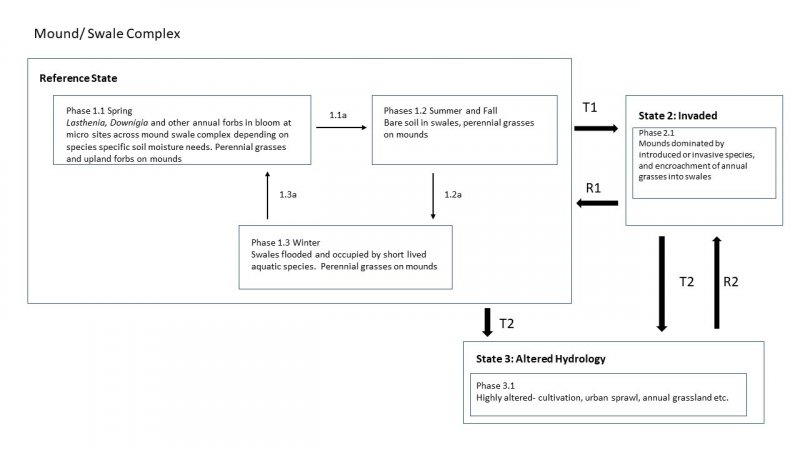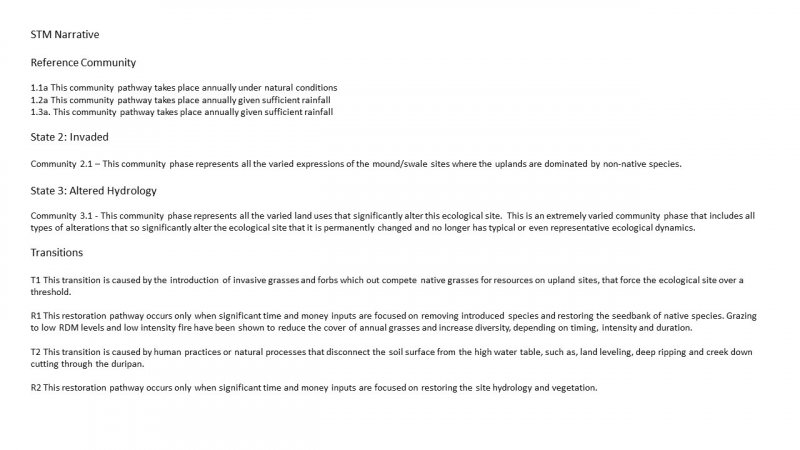Ecological site group R017XY902CAESG
Duripan Vernal Pools
Last updated: 06/03/2024
Accessed: 12/22/2025
Ecological site group description
Key Characteristics
- Landform Not As Above
- Mound and Swale Landscape Over Duripan
Provisional. A provisional ecological site description has undergone quality control and quality assurance review. It contains a working state and transition model and enough information to identify the ecological site.
Physiography
This site historically occurred on the terraces of all major alluvial fans in the Central Valley. These ancient surfaces developed cemented duripans, or impervious claypans through pedogenic processes, which produce a perched water table that creates seasonal ponding at low lying positions following heavy rain. The season nature of these wetland sites defines them as vernal pools.
Climate
The average annual precipitation is 5 to 12 inches (125 to 305 millimeters) in the San Joaquin Valley. The Tulare Basin, at the southern end of this MLRA, typically receives less than 6 inches (150 millimeters) of rainfall per year. The average annual precipitation is 12 to 30 inches (305 to 760 millimeters) in most of the Sacramento Valley. It is 40 inches (1,015 millimeters) at the higher elevations on the edges of the valley at the north end. Summers are long, hot, and dry, and winters are cool and rainy. Most of the rainfall occurs as low- or moderateintensity, Pacific frontal storms from October to May. Snow is very rare in this MLRA but has occurred in the Sacramento Valley from Sacramento to points farther north. The average annual temperature is 59 to 67 degrees F (15 to 20 degrees C), decreasing from south to north. The freeze-free period averages 325 days and ranges from 280 to 365 days, decreasing in length with elevation and from south to north.
Soil features
This ecological site is associated with soils mapped extensively across the MLRA, including the San Joaquin, Redding and Corning series. Multiple site specific soil properties, most significantly depth to duripan, have been shown play a role in the level of diversity and community composition at the site. (Holland and Dain, 1990)
Holland and Dain: The Edaphic Factor in Vernal Pool Vegetation, 1990
Vegetation dynamics
Vernal pools and their associated upland are one of the MLRA’s most iconic vegetation communities, and a hotspot of biodiversity. The species composition varies from year to year even at the alliance level because the species are annual and germinate in response to specific water depth and temperature factors, which fluctuate in response to amount and timing of rainfall (Sawyer et. al., 2009). Some common plant alliances at these wetland sites are Lasthenia fremontii- Downingia Lasthenia glaberrima, and Leyia fremontii, (Sawyer et. al., 2009) the upland sites are believed to have historically been dominated by perennial bunch grasses but are currently occupied principally by California annual grass communities.
These wetland sites are critical habitat for threatened fairy shrimp species and are currently protected by federal regulation. The uplands are home to a great diversity of ground nesting bees many of which are the only pollinator species of specific vernal pool plants (Thorp and Leong, 1998). Historically this mound swale complex may have occupied up to 25% of MLRA 17, but it has largely been converted to agriculture or residential developments. A 2012 inventory of vernal pool habitat found only 765,000 acres remain, which is roughly 0.5%.
Invasive species and introduced annual grasses have crossed a threshold at the majority of sites. Though they invasive principally occupy the upland sites they have been shown to impact they hydrology of the swales and pools by decreasing the length of ponding (Faist and Beal, 2017) They may also occupy the swale sites during dry years leaving behind thatch which can reduce the success of wetland forbs in future years (Pollak and Kan, 1998) There are also invasive species that occupy the wetland sites such as waxy mannagrass. Both grazing and prescribed fire have been shown to increase native plant abundance with appropriate timing and intensity (Pollak 1992).
Because the site must have both a wet period and a dry period annually it is susceptible to multiple causes of conversion. Land leveling removes pools, deep ripping or other activities that fracture the duripan remove the perched water table causing conversion to a grassland site and summer runoff from adjacent agricultural land is able to convert the site to a freshwater marsh (Witham et. al., 2014).
Restoration efforts generally have involved artificially recreating the perched water table and mound swale topography then reintroducing native species. These efforts have shown varying degrees of success (Moore et. al., 2003).
References/Citations:
Faist, A. M., & Beals, S. C. 2018. Invasive plant feedbacks promote alternative states in California vernal pools. Restoration Ecology, 26(2), 255-263.
Keeler-Wolf, T., J.O. Sawyer, and J. Evans. 2009. A Manual of California Vegetation. Edition, 2. California Native Plant Society Press.
Moore, C., Bastian, M., & Hunt, H. 2003. Long term evaluation of characteristics in an artificial Northern California vernal pool system (No. FHWA/CA/TL-2002/24). California. Dept. of Transportation.
Pollak, O., & Kan, T. 1998. The use of prescribed fire to control invasive exotic weeds at Jepson Prairie Preserve. In Ecology, Conservation, and Management of Vernal Pool Ecosystems–Proceedings from a 1996 Conference. California Native Plant Society, Sacramento, CA: 241-249.
Thorp, R. W., & Leong, J. M. 1995. Determining effective mitigation techniques for vernal pool wetlands: Effect of host-specific pollinators on vernal pool plants (No. FHWA/CA/TL-96/24).
Witham, C. W., Holland, R. F., & Vollmar, J. E. 2014. Changes in the distribution of great valley vernal pool habitats from 2005 to 2012 Sacramento, CA: Report Prepared for the US Fish and Wildlife Service and Bureau of Reclamation CVPIA Habitat Restoration Program under Grant Agreement No. F11AP00169 with the USFWS.[Google Scholar].
Major Land Resource Area
MLRA 017X
Sacramento and San Joaquin Valleys
Subclasses
- R017XD001CA–CLAYEY
- R017XD045CA–LOAMY
- R017XD047CA–LOAMY CLAYPAN
- R017XD079CA–CLAYPAN TERRACE
- R017XD081CA–LOAM STREAM TERRACE
- R017XD084CA–STONY CLAY
- R017XD090CA–GRAVELLY LOAMY
- R017XD091CA–GRAVELLY LOAMY INTERMOUND
- R017XD093CA–CLAYPAN
- R017XE100CA–GRAVELLY LOAMY
- R017XE104CA–LOAMY CLAYPAN
- R017XE105CA–GRAVELLY LOAMY CLAYPAN
- R017XE113CA–TERRACE 12-14"
- R017XE116CA–ALKALI HARDPAN
- R017XY902CA–Duripan Vernal Pools
Stage
Provisional
Click on box and path labels to scroll to the respective text.
Ecosystem states
| T1 | - | Establishment of Invasive Species |
|---|---|---|
| T2 | - | Alteration of Site Hydrology |
| R1 | - | Management of Invasive Species |
| R2 | - | Restoration of Hydrology |
State 1 submodel, plant communities
| 1.1a | - | Seasonal Change |
|---|---|---|
| 1.2a | - | Seasonal Change |
| 1.3a | - | Seasonal Change |

